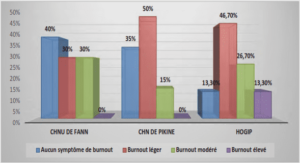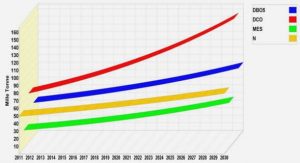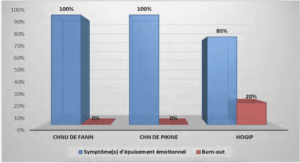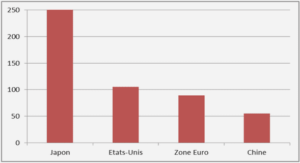Propagation de fronts structurés en biologie –
Modélisation et analyse mathématique
Equations cinétiques de transport-réaction
Le cas d’un continuum de vitesses Dans cet article en collaboration avec Vincent Calvez et Grégoire Nadin, nous étudions l’existence et la stabilité d’ondes progressives solutions d’un modèle cinétique de transport-réaction. Le modèle décrit des particules qui se déplacent en changeant de direction via un processus de saut en vitesse (« velocity-jump process ») et qui prolifèrent via un terme de réaction de type monostable. Le caractère borné ou non se révèle être une condition nécessaire et suffisante pour l’existence d’ondes progressives positives. La vitesse minimale d’existence de ces ondes est obtenue à partir d’une relation de dispersion explicite. Nous construisons les ondes en utilisant une technique de sur- et sous- solutions et prouvons qu’elles sont stables (dans un sens faible) dans un espace L2 à poids. Dans le cas d’un espace de vitesses non-borné, nous prouvons que la propagation est sur-linéaire. Il apparait que la vitesse de propagation dépend fortement de la décroissance à l’infini de la distribution stationnaire. Dans le cas d’une distribution Gaussienne, nous prouvons que le front se propage comme x ∼ t 3 2 .
Accelerating fronts for a Gaussian distribution
Accelerating fronts in reaction-diffusion equations have raised a lot of interest in the recent years. They occur for the Fisher-KPP equation (7.2) when the initial datum decays more slowly than any exponential [123]. They also appear when the diffusion operator is replaced by a nonlocal dispersal operator with fat tails [144, 153, 107], or by a nonlocal fractional diffusion operator [46, 45]. Recently, accelerating fronts have been conjectured to occur in a reactiondiffusion-mutation model which generalizes the Fisher-KPP equation to a population structured with respect to the diffusion coefficient [34]. Here, we investigate the case of a Gaussian distribution M. The spreading rate hxi = O(t 3/2) is expected in this case (heuristics, and see [166]). We prove that spreading occurs with this rate. For this purpose, we build suitable sub- and supersolution which spread with this rate. We split our results into two parts, respectively the upper bound and the lower bound of the spreading rate. The reason is that the constructions are quite different. The construction of the supersolution relies on a first guess inspired from [107], plus convolution tricks which are made easier in the gaussian case. On the other hand, the construction of the subsolution is based on a better comprehension of the growth-dispersion process. Again, some technical estimates are facilitated in the gaussian case. We believe that these results can be generalized to a large class of distributions M, at the expense of clarity.
Preliminary results
We first recall some useful results concerning the Cauchy problem associated with (2.1) : well-posedness and a strong maximum principle. These statements extend some results given in [69]. They do not rely on the boundedness of V. Proposition 2.13 (Global existence : Theorem 4 in [69]). Let g0 a measurable function such that 0 ≤ g 0 (x, v) ≤ M(v) for all (x, v) ∈ R × V. Then the Cauchy problem (2.1) has a unique solution g ∈ C0 b (R+ × R × V) in the sense of distributions, satisfying (∀(t, x, v) ∈ R+ × R × V) 0 ≤ g(t, x, v) ≤ M(v). The next result refines the comparison principle of [69] in order to extend it to sub and supersolutions in the sense of distributions and to state a strong maximum principle. Its proof is given in Appendix. Proposition 2.14 (Comparison principle). Assume that u1, u2 ∈ C(R+, L ∞(R × V)) are respectively a super- and a subsolution of (2.1), i.e. ∂tg1 + v∂x g1 ≥
Existence and construction of travelling wave solutions
We assume throughout this Section that V = Supp M is compact. We construct the travelling waves for c ∈ [c ∗ , vmax). The proof is divided into several steps. It is based on a sub and supersolutions method. 69 Chapitre 2. Equations cinétiques de transport-réaction : Le cas d’un continuum de vitesses 2.3.1 The linearized problem. The aim of this first step is to solve the linearized equation of (6.2) at +∞, in the regime of low density f 1. Such an achievement gives information about the speed and the space decreasing rate of a travelling wave solution of the nonlinear problem, as for the Fisher-KPP equation. The linearization of (6.2) at f = 0 writes (v − c)∂x f =
Construction of the travelling waves in the regime c ∈ (c ∗ , vmax)
Let c ∈ (c ∗ , vmax), where c ∗ denotes the minimal speed of Proposition 2.16. In order to prove the existence of travelling waves, we will prove that the solution of the following evolution equation, corresponding to equation (2.1) in the moving frame at speed c, converges to a travelling wave as t → +∞ : ( ∂tg + (v − c)∂x g = M(v)ρg − g + rρg (M(v) − g) in R × V, g(0, x, v) = f(x, v) for all (x, v) ∈ R × V. (2.20) The well-posedness of equation (2.20) immediately follows from Proposition 2.13. Let now derive some properties of the function g from Proposition 2.14. Lemma 2.21. For all (t, x, v) ∈ R+ × R × V, one has f(x, v) ≤ g(t, x, v) ≤ f(x, v). Proof of Lemma 2.21. As f is a subsolution of (2.20) and f is a supersolution of (2.20), with f(x, v) ≤ f(x, v) for all (x, v) ∈ R × V, this result is an immediate corollary of Proposition 2.14. Lemma 2.22. For all (t, v) ∈ R+ × V, the function x ∈ R 7→ g(t, x, v) is nonincreasing. Proof of Lemma 2.22. Take h ≥ 0 and define gh(t, x, v) = g(t, x + h, v). Then as f is nonincreasing in x, one has gh(0, x, v) ≤ g(0, x, v) for all (x, v) ∈ R × V. Proposition 2.14 yields that gh(t, x, v) ≤ g(t, x, v) for all (t, x, v) ∈ R+ × R × V. Lemma 2.23. For all (x, v) ∈ R × V, the function t ∈ R+ 7→ g(t, x, v) is nonincreasing. Proof of Lemma 2.23. Take τ ≥ 0 and define gτ(t, x, v) = g(t + τ, x, v). Then Lemma 2.21 yields that gτ(0, x, v) ≤ f(x, v) = g(0, x, v) for all (x, v) ∈ R × V. Hence, Proposition 2.14 gives gτ(t, x, v) ≤ g(t, x, v) for all (t, x, v) ∈ R+ × R × V. Lemma 2.24. The family (g(t, ·, ·))t≥0 is uniformly continuous with respect to (x, v) ∈ R × V. Moreover, for any A ∈ (c ∗ , vmax), the continuity constants does not depend on c ∈ (c ∗ , A). Proof of Lemma 2.24. We begin with the space regularity. Let |h| < 1. The function g(0, x, v) = f(x, v) = min{M(v),e −λxFλ(v)} is such that log g(0, x, v) is Lipschitz-continuous with respect to x. Therefore there exists a constant C0 > 0 such that for all (x, v) ∈ R × V, we have g(0, x + h, v) ≤ (1 + C0|h|)g(0, x, v). As 1 + C0|h| > 1, it is easily checked that (t, x, v) 7→ (1 + C0|h|)g(t, x − h, v) is a supersolution of (2.20). Hence Proposition 2.14 yields that g(t, x, v) ≤ (1 + C0|h|)g(t, x − h, v) for all (t, x, v) ∈ R+ × R × V . Hence the function log g is Lipschitz continuous with respect to x. Since the function log g is bounded from above, g = exp(log g) is also Lipschitz continuous with respect to x. The Lipschitz constant is uniform with respect to c ∈ (c ∗ , A) and λ ∈ (0, 1/(vmax − c)). We now come to the velocity regularity. For the sake of clarity we first consider the case where M is C 1 on V. The function v 7→ g(0, x, v) is C 1 too. We introduce gv = ∂vg. It satisfies the following equation ∂tgv + (v − c)∂x gv + (1 + rρg)gv = (1 + r)M0 (v)ρg − ∂x g in R × V .
Construction of the travelling waves with minimal speed c ∗
Proof of the existence in Theorem 2.2 when c = c ∗ . Consider a decreasing sequence (cn) converging towards c ∗ . We already know that for all n, equation (2.1) admits a travelling wave solution un(t, x, v) = fn(x − cnt, v), with fn(−∞, v) = M(v) and fn(+∞, v) = 0, and z 7→ fn(z, v) is nonincreasing. Up to translation, we can assume that ρfn (0) = 1/2. Moreover, Lemma 2.24 ensures that the functions (fn)n are uniformly continuous with respect to (x, v) ∈ R × V since the continuity stated in Lemma 2.24 is uniform with respect to c ∈ (c ∗ , A) for any A ∈ (c ∗ , vmax). Thanks to the Ascoli theorem and a diagonal extraction process, we can assume that the sequence (fn)n converges locally uniformly in (x, v) ∈ R × V to a function f . Clearly f satisfies (6.2) in the sense of distributions. Moreover, as f is nonincreasing with respect to x, one could recover the appropriate limits at infinity with the same arguments as in the proof of the existence of travelling waves with speeds c > c ∗ . 2.3.5 Non-existence of travelling wave solutions in the subcritical regime c ∈ [0, c ∗ ). Lemma 2.25. Assume that infV M(v) > 0. For all 0 ≤ c < c ∗ there exists c < c0 < c ∗ and a nonnegative, arbitrarily small, compactly supported function h(x, v) which is a subsolution of (v − c 0 )∂x f = M(v)ρf − f + rρf (M(v) − f) in R × V . (2.22) Proof of Lemma 2.25. For the sake of clarity we emphasize the dependence of the function I (2.15) upon the growth rate r > 0 : Ir(λ; c) = Z V (1 + r)M(v) 1 + λ(c − v) dv . We denote by c ∗ r the smallest speed such that there exists a solution λ > 0 of Ir(λ, c) = 1 (see Proposition 2.16). Let δ > 0. By continuity we can choose δ so small that c < c ∗ r−δ . We claim that there exists (c 0 , λ 0 ) such that Ir−δ(λ 0 ; c 0 ) = 1, with c < c 0 < c ∗ r−δ and λ 0 ∈ C \ R. Indeed we know from the proof of Proposition 2.16 [Step 3] that λ ∗ r < 1/(vmax − c ∗ r ) under the assumption v 7→ M(v)/(vmax − v) ∈/ L 1 (V). Using a continuity argument we also have the strict inequality λ ∗ r−δ < 1/(vmax − c ∗ r−δ ), uniformly with respect to δ. The complex function λ 7→ Ir−δ(λ; c ∗ r−δ ) is analytic in a neighborhood of λ ∗ r−δ . Hence, the Rouché theorem yields that there exists c 0 < c ∗ r−δ such that the equation Ir−δ(λ; c 0 ) = 1 has a solution λ 0 ∈ C with λ 0 arbitrarily close to λ ∗ r−δ . We denote by F 0 (v) the corresponding velocity profile, F 0 (v) = (1 + r − δ)M(v) 1 + λ0(c 0 − v) , Z V F 0 (v) dv = 1 . By continuity we can choose c 0 and λ 0 such that Re
Introduction |




